Analysing Innovation & Commercialisation for Business Development
VerifiedAdded on 2024/06/04
|23
|4931
|370
Report
AI Summary
This report analyses the concepts of innovation and commercialisation within the context of Healthy Juice, a business facing declining profits due to increased market competition. It explores various aspects of innovation, including its importance compared to invention, how organisational vision, leadership, culture, and teamwork shape innovation, and different sources of innovation. The report also delves into the 4Ps of innovation (Paradigm, Product, Process, and Position) and the application of the innovation funnel to shape innovative ideas. Furthermore, it examines frugal innovation, its developments, and its use in an organisational context, along with the importance of the commercial funnel and new product development (NPD) processes for commercialisation. The report also covers building an innovation business case, measuring its effectiveness, and evaluating tools for developing, retaining, and protecting knowledge and intellectual property. It concludes with a critical analysis of how innovation is developed, embedded, and measured in an organisational context, providing evidence-based judgements on overcoming challenges to develop successful innovations.
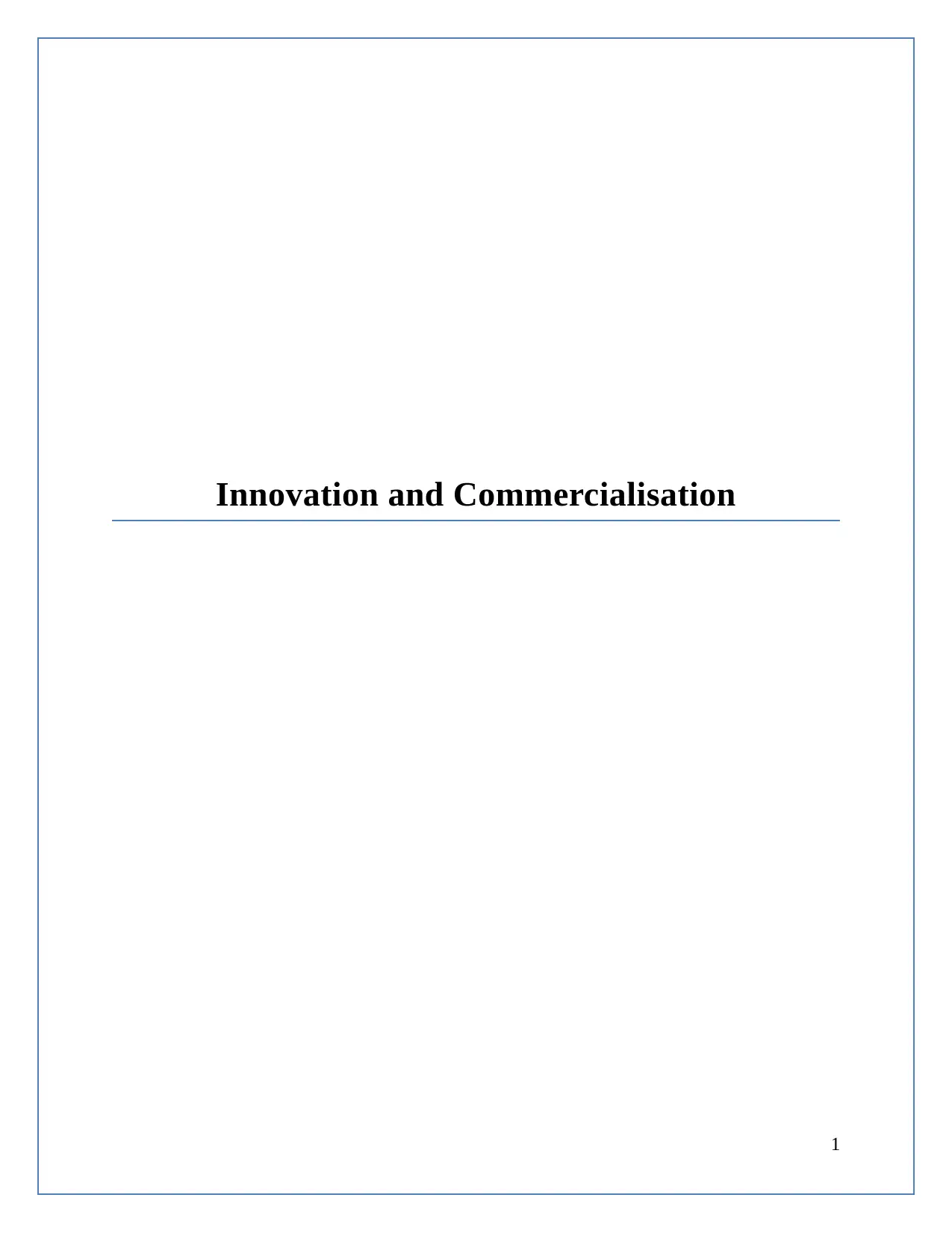
Innovation and Commercialisation
1
1
Paraphrase This Document
Need a fresh take? Get an instant paraphrase of this document with our AI Paraphraser
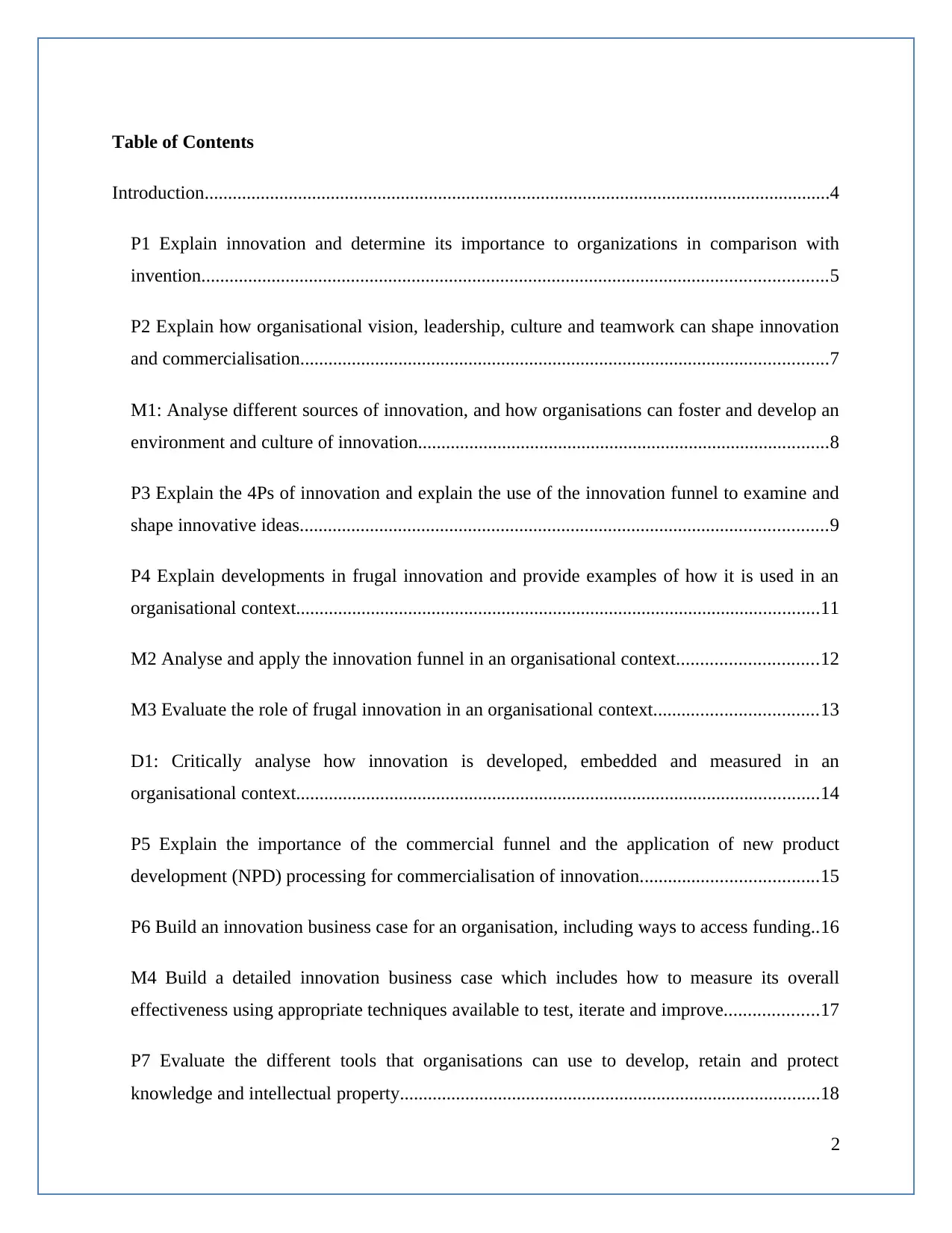
Table of Contents
Introduction......................................................................................................................................4
P1 Explain innovation and determine its importance to organizations in comparison with
invention......................................................................................................................................5
P2 Explain how organisational vision, leadership, culture and teamwork can shape innovation
and commercialisation.................................................................................................................7
M1: Analyse different sources of innovation, and how organisations can foster and develop an
environment and culture of innovation........................................................................................8
P3 Explain the 4Ps of innovation and explain the use of the innovation funnel to examine and
shape innovative ideas.................................................................................................................9
P4 Explain developments in frugal innovation and provide examples of how it is used in an
organisational context................................................................................................................11
M2 Analyse and apply the innovation funnel in an organisational context..............................12
M3 Evaluate the role of frugal innovation in an organisational context...................................13
D1: Critically analyse how innovation is developed, embedded and measured in an
organisational context................................................................................................................14
P5 Explain the importance of the commercial funnel and the application of new product
development (NPD) processing for commercialisation of innovation......................................15
P6 Build an innovation business case for an organisation, including ways to access funding..16
M4 Build a detailed innovation business case which includes how to measure its overall
effectiveness using appropriate techniques available to test, iterate and improve....................17
P7 Evaluate the different tools that organisations can use to develop, retain and protect
knowledge and intellectual property..........................................................................................18
2
Introduction......................................................................................................................................4
P1 Explain innovation and determine its importance to organizations in comparison with
invention......................................................................................................................................5
P2 Explain how organisational vision, leadership, culture and teamwork can shape innovation
and commercialisation.................................................................................................................7
M1: Analyse different sources of innovation, and how organisations can foster and develop an
environment and culture of innovation........................................................................................8
P3 Explain the 4Ps of innovation and explain the use of the innovation funnel to examine and
shape innovative ideas.................................................................................................................9
P4 Explain developments in frugal innovation and provide examples of how it is used in an
organisational context................................................................................................................11
M2 Analyse and apply the innovation funnel in an organisational context..............................12
M3 Evaluate the role of frugal innovation in an organisational context...................................13
D1: Critically analyse how innovation is developed, embedded and measured in an
organisational context................................................................................................................14
P5 Explain the importance of the commercial funnel and the application of new product
development (NPD) processing for commercialisation of innovation......................................15
P6 Build an innovation business case for an organisation, including ways to access funding..16
M4 Build a detailed innovation business case which includes how to measure its overall
effectiveness using appropriate techniques available to test, iterate and improve....................17
P7 Evaluate the different tools that organisations can use to develop, retain and protect
knowledge and intellectual property..........................................................................................18
2
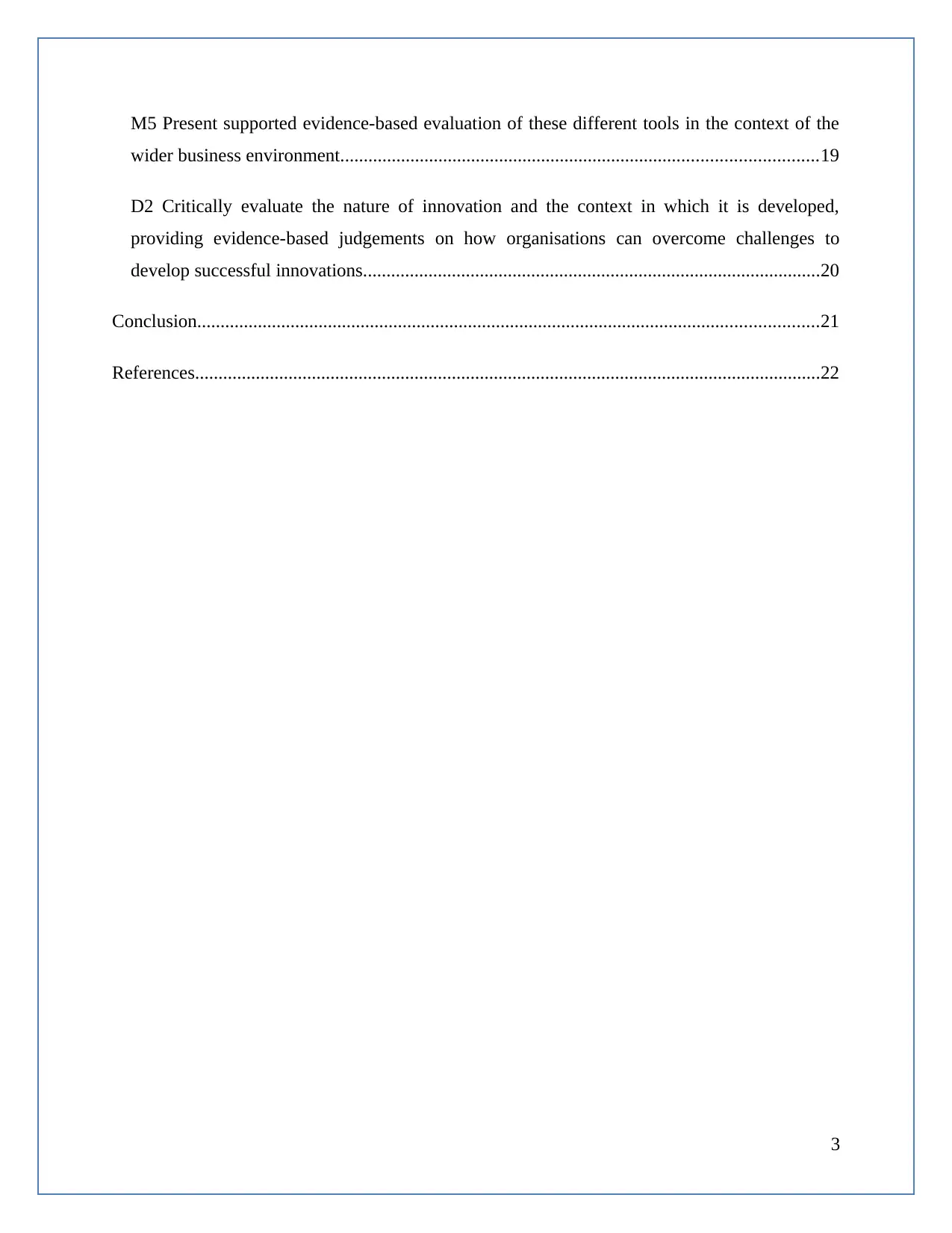
M5 Present supported evidence-based evaluation of these different tools in the context of the
wider business environment......................................................................................................19
D2 Critically evaluate the nature of innovation and the context in which it is developed,
providing evidence-based judgements on how organisations can overcome challenges to
develop successful innovations..................................................................................................20
Conclusion.....................................................................................................................................21
References......................................................................................................................................22
3
wider business environment......................................................................................................19
D2 Critically evaluate the nature of innovation and the context in which it is developed,
providing evidence-based judgements on how organisations can overcome challenges to
develop successful innovations..................................................................................................20
Conclusion.....................................................................................................................................21
References......................................................................................................................................22
3
⊘ This is a preview!⊘
Do you want full access?
Subscribe today to unlock all pages.

Trusted by 1+ million students worldwide
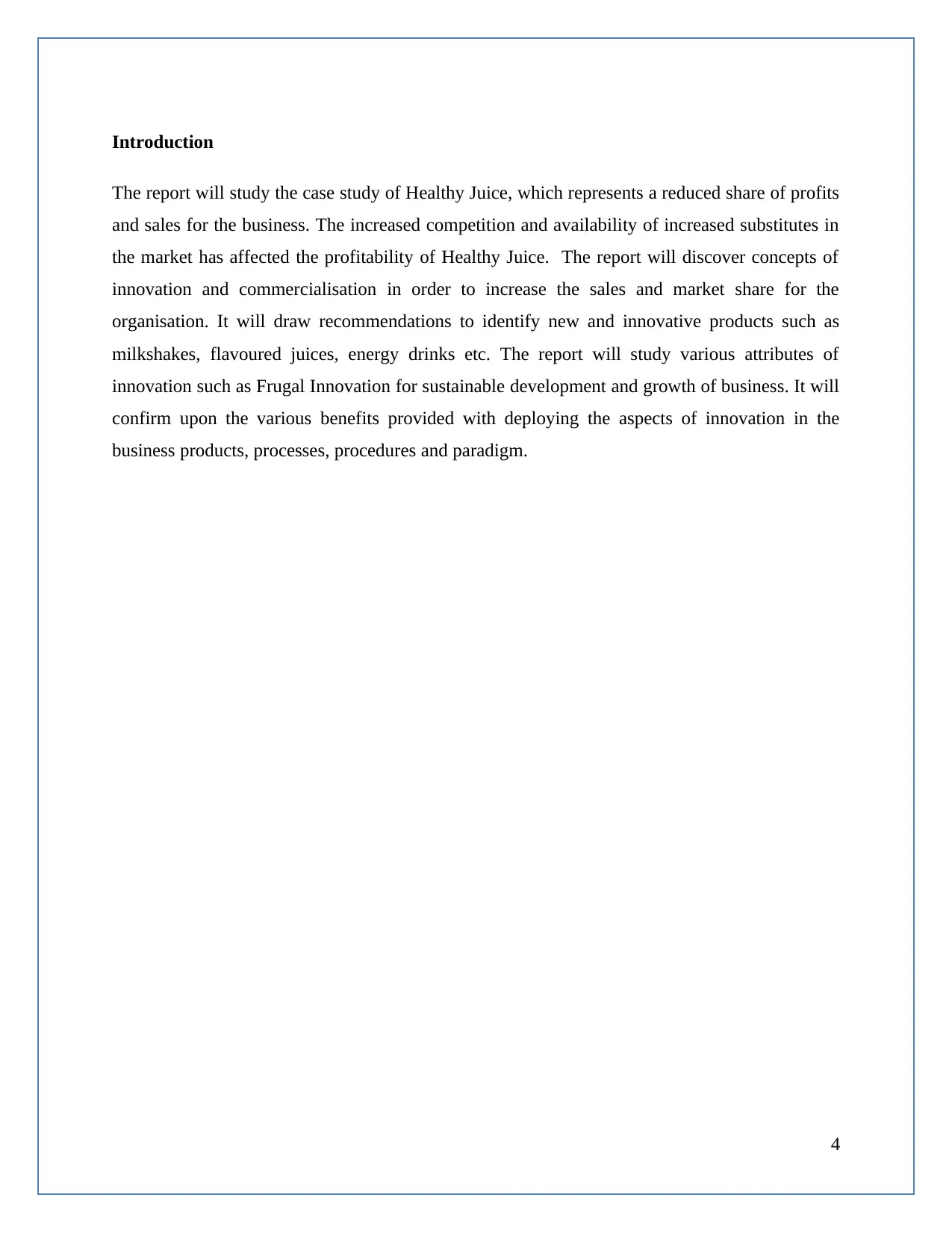
Introduction
The report will study the case study of Healthy Juice, which represents a reduced share of profits
and sales for the business. The increased competition and availability of increased substitutes in
the market has affected the profitability of Healthy Juice. The report will discover concepts of
innovation and commercialisation in order to increase the sales and market share for the
organisation. It will draw recommendations to identify new and innovative products such as
milkshakes, flavoured juices, energy drinks etc. The report will study various attributes of
innovation such as Frugal Innovation for sustainable development and growth of business. It will
confirm upon the various benefits provided with deploying the aspects of innovation in the
business products, processes, procedures and paradigm.
4
The report will study the case study of Healthy Juice, which represents a reduced share of profits
and sales for the business. The increased competition and availability of increased substitutes in
the market has affected the profitability of Healthy Juice. The report will discover concepts of
innovation and commercialisation in order to increase the sales and market share for the
organisation. It will draw recommendations to identify new and innovative products such as
milkshakes, flavoured juices, energy drinks etc. The report will study various attributes of
innovation such as Frugal Innovation for sustainable development and growth of business. It will
confirm upon the various benefits provided with deploying the aspects of innovation in the
business products, processes, procedures and paradigm.
4
Paraphrase This Document
Need a fresh take? Get an instant paraphrase of this document with our AI Paraphraser
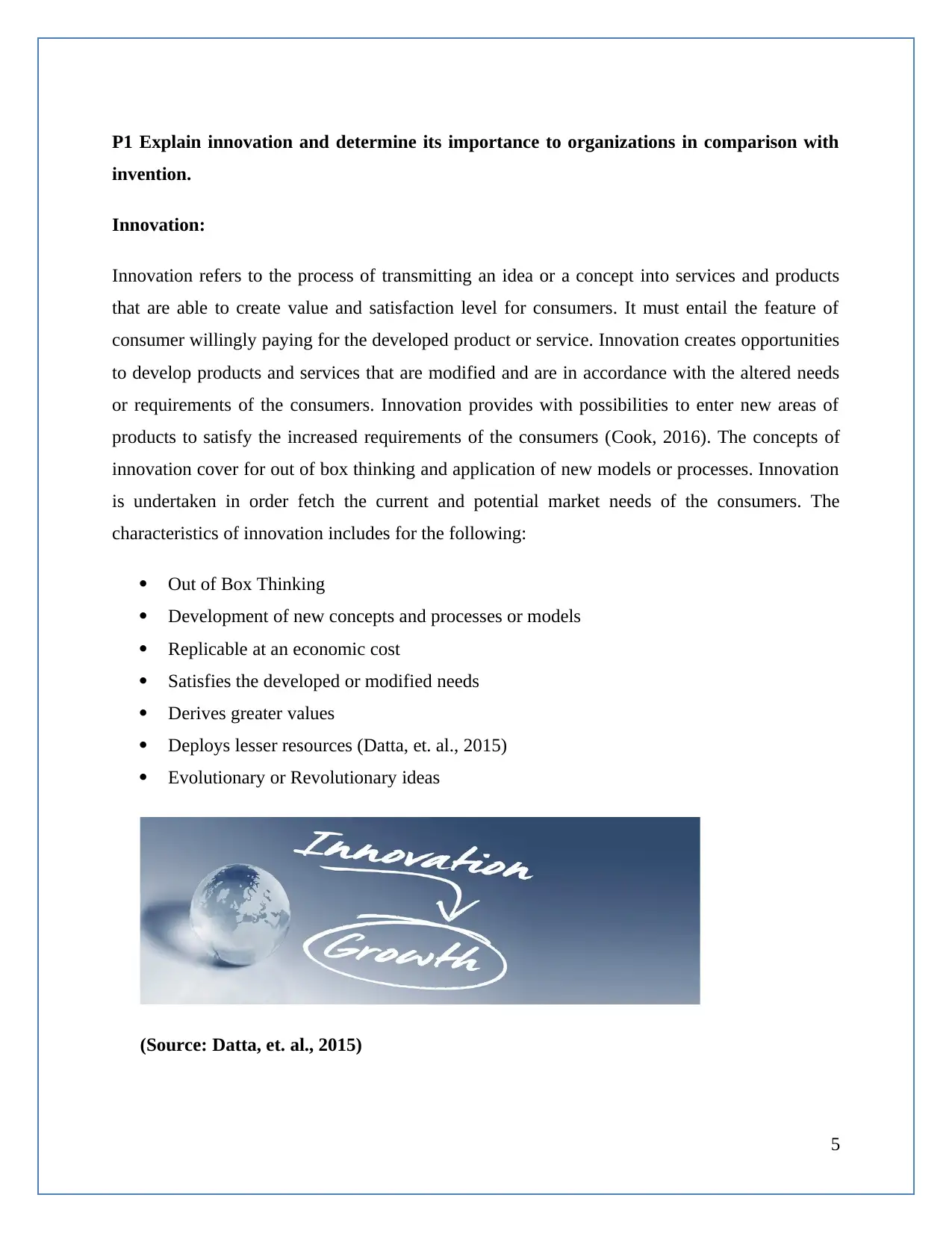
P1 Explain innovation and determine its importance to organizations in comparison with
invention.
Innovation:
Innovation refers to the process of transmitting an idea or a concept into services and products
that are able to create value and satisfaction level for consumers. It must entail the feature of
consumer willingly paying for the developed product or service. Innovation creates opportunities
to develop products and services that are modified and are in accordance with the altered needs
or requirements of the consumers. Innovation provides with possibilities to enter new areas of
products to satisfy the increased requirements of the consumers (Cook, 2016). The concepts of
innovation cover for out of box thinking and application of new models or processes. Innovation
is undertaken in order fetch the current and potential market needs of the consumers. The
characteristics of innovation includes for the following:
Out of Box Thinking
Development of new concepts and processes or models
Replicable at an economic cost
Satisfies the developed or modified needs
Derives greater values
Deploys lesser resources (Datta, et. al., 2015)
Evolutionary or Revolutionary ideas
(Source: Datta, et. al., 2015)
5
invention.
Innovation:
Innovation refers to the process of transmitting an idea or a concept into services and products
that are able to create value and satisfaction level for consumers. It must entail the feature of
consumer willingly paying for the developed product or service. Innovation creates opportunities
to develop products and services that are modified and are in accordance with the altered needs
or requirements of the consumers. Innovation provides with possibilities to enter new areas of
products to satisfy the increased requirements of the consumers (Cook, 2016). The concepts of
innovation cover for out of box thinking and application of new models or processes. Innovation
is undertaken in order fetch the current and potential market needs of the consumers. The
characteristics of innovation includes for the following:
Out of Box Thinking
Development of new concepts and processes or models
Replicable at an economic cost
Satisfies the developed or modified needs
Derives greater values
Deploys lesser resources (Datta, et. al., 2015)
Evolutionary or Revolutionary ideas
(Source: Datta, et. al., 2015)
5
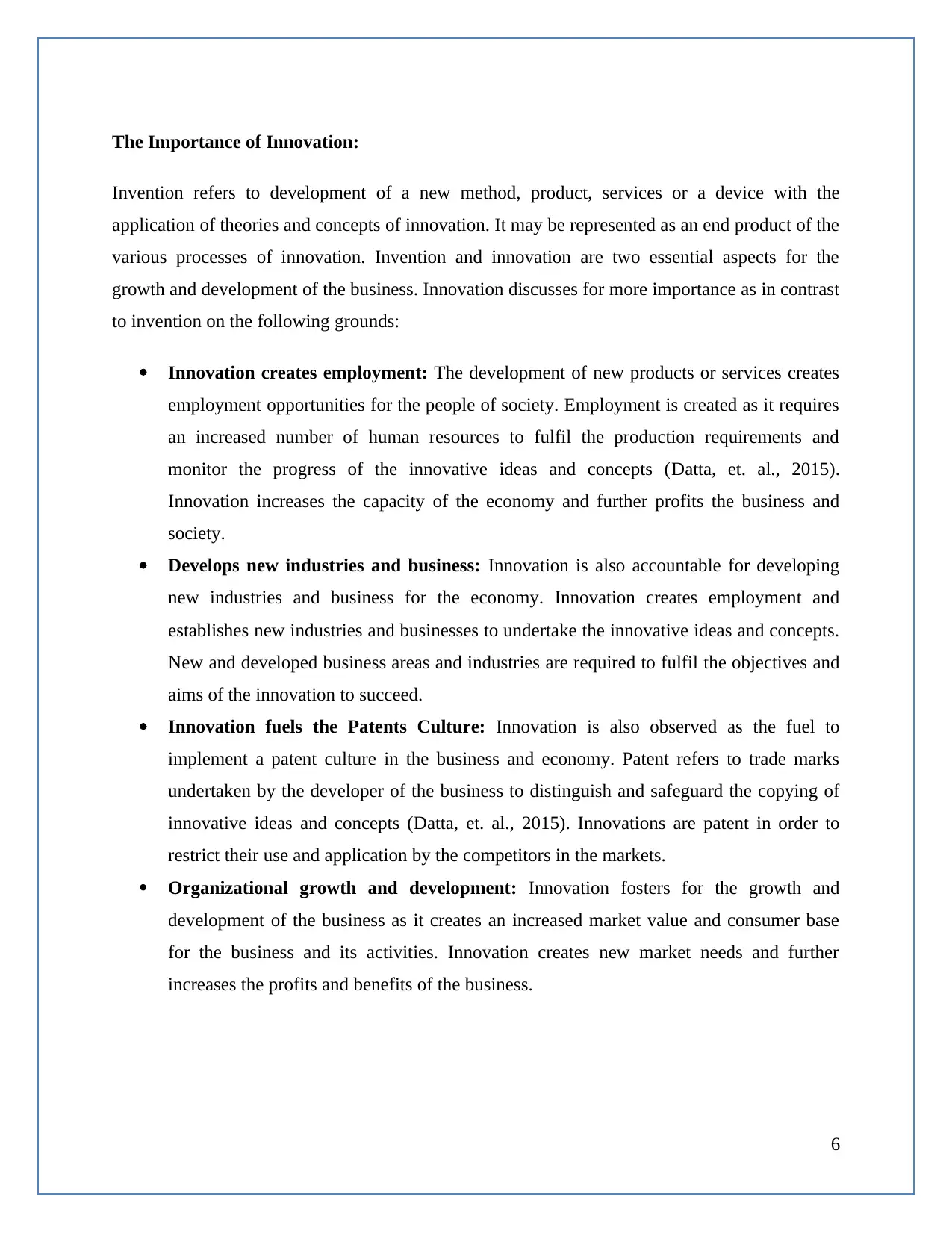
The Importance of Innovation:
Invention refers to development of a new method, product, services or a device with the
application of theories and concepts of innovation. It may be represented as an end product of the
various processes of innovation. Invention and innovation are two essential aspects for the
growth and development of the business. Innovation discusses for more importance as in contrast
to invention on the following grounds:
Innovation creates employment: The development of new products or services creates
employment opportunities for the people of society. Employment is created as it requires
an increased number of human resources to fulfil the production requirements and
monitor the progress of the innovative ideas and concepts (Datta, et. al., 2015).
Innovation increases the capacity of the economy and further profits the business and
society.
Develops new industries and business: Innovation is also accountable for developing
new industries and business for the economy. Innovation creates employment and
establishes new industries and businesses to undertake the innovative ideas and concepts.
New and developed business areas and industries are required to fulfil the objectives and
aims of the innovation to succeed.
Innovation fuels the Patents Culture: Innovation is also observed as the fuel to
implement a patent culture in the business and economy. Patent refers to trade marks
undertaken by the developer of the business to distinguish and safeguard the copying of
innovative ideas and concepts (Datta, et. al., 2015). Innovations are patent in order to
restrict their use and application by the competitors in the markets.
Organizational growth and development: Innovation fosters for the growth and
development of the business as it creates an increased market value and consumer base
for the business and its activities. Innovation creates new market needs and further
increases the profits and benefits of the business.
6
Invention refers to development of a new method, product, services or a device with the
application of theories and concepts of innovation. It may be represented as an end product of the
various processes of innovation. Invention and innovation are two essential aspects for the
growth and development of the business. Innovation discusses for more importance as in contrast
to invention on the following grounds:
Innovation creates employment: The development of new products or services creates
employment opportunities for the people of society. Employment is created as it requires
an increased number of human resources to fulfil the production requirements and
monitor the progress of the innovative ideas and concepts (Datta, et. al., 2015).
Innovation increases the capacity of the economy and further profits the business and
society.
Develops new industries and business: Innovation is also accountable for developing
new industries and business for the economy. Innovation creates employment and
establishes new industries and businesses to undertake the innovative ideas and concepts.
New and developed business areas and industries are required to fulfil the objectives and
aims of the innovation to succeed.
Innovation fuels the Patents Culture: Innovation is also observed as the fuel to
implement a patent culture in the business and economy. Patent refers to trade marks
undertaken by the developer of the business to distinguish and safeguard the copying of
innovative ideas and concepts (Datta, et. al., 2015). Innovations are patent in order to
restrict their use and application by the competitors in the markets.
Organizational growth and development: Innovation fosters for the growth and
development of the business as it creates an increased market value and consumer base
for the business and its activities. Innovation creates new market needs and further
increases the profits and benefits of the business.
6
⊘ This is a preview!⊘
Do you want full access?
Subscribe today to unlock all pages.

Trusted by 1+ million students worldwide
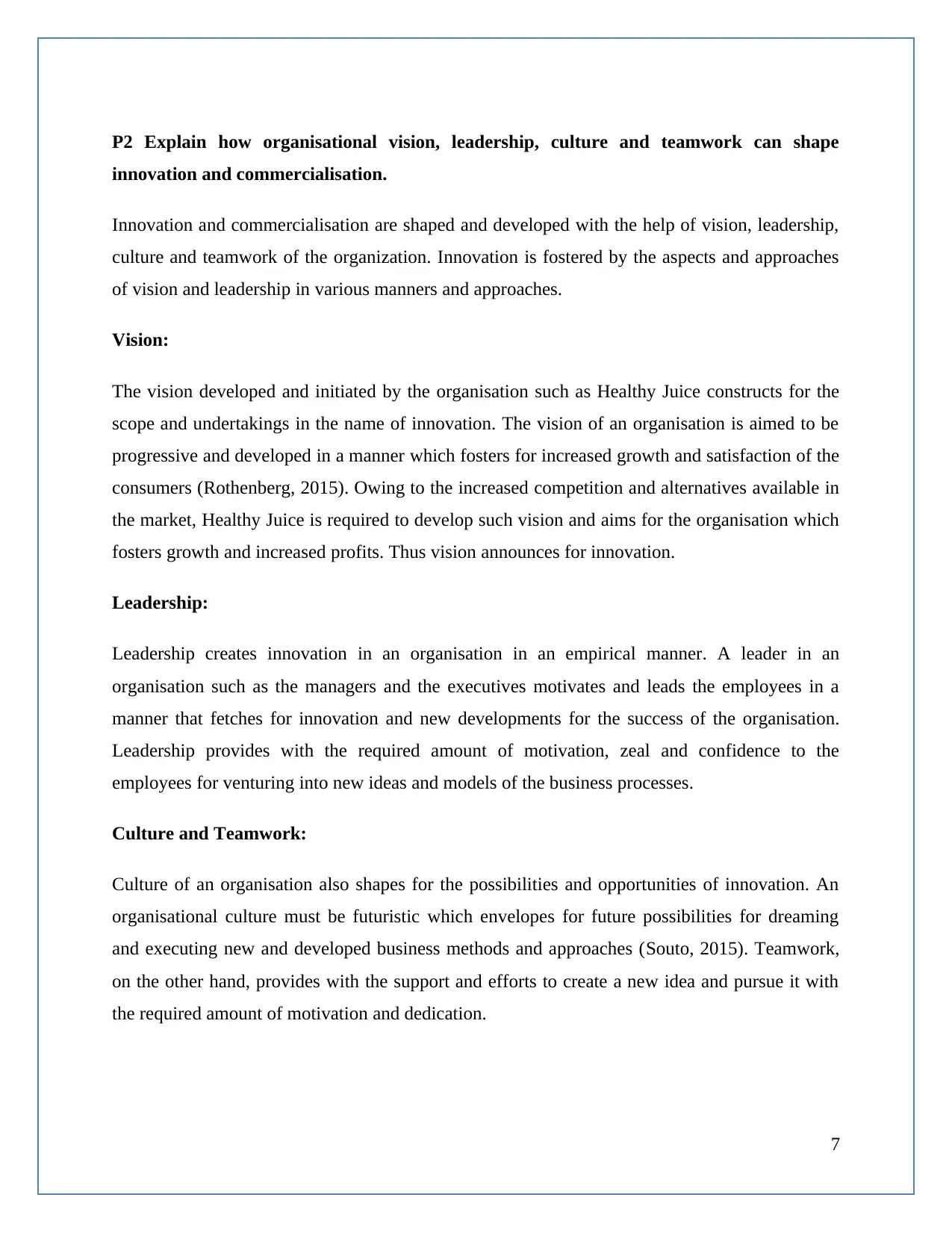
P2 Explain how organisational vision, leadership, culture and teamwork can shape
innovation and commercialisation.
Innovation and commercialisation are shaped and developed with the help of vision, leadership,
culture and teamwork of the organization. Innovation is fostered by the aspects and approaches
of vision and leadership in various manners and approaches.
Vision:
The vision developed and initiated by the organisation such as Healthy Juice constructs for the
scope and undertakings in the name of innovation. The vision of an organisation is aimed to be
progressive and developed in a manner which fosters for increased growth and satisfaction of the
consumers (Rothenberg, 2015). Owing to the increased competition and alternatives available in
the market, Healthy Juice is required to develop such vision and aims for the organisation which
fosters growth and increased profits. Thus vision announces for innovation.
Leadership:
Leadership creates innovation in an organisation in an empirical manner. A leader in an
organisation such as the managers and the executives motivates and leads the employees in a
manner that fetches for innovation and new developments for the success of the organisation.
Leadership provides with the required amount of motivation, zeal and confidence to the
employees for venturing into new ideas and models of the business processes.
Culture and Teamwork:
Culture of an organisation also shapes for the possibilities and opportunities of innovation. An
organisational culture must be futuristic which envelopes for future possibilities for dreaming
and executing new and developed business methods and approaches (Souto, 2015). Teamwork,
on the other hand, provides with the support and efforts to create a new idea and pursue it with
the required amount of motivation and dedication.
7
innovation and commercialisation.
Innovation and commercialisation are shaped and developed with the help of vision, leadership,
culture and teamwork of the organization. Innovation is fostered by the aspects and approaches
of vision and leadership in various manners and approaches.
Vision:
The vision developed and initiated by the organisation such as Healthy Juice constructs for the
scope and undertakings in the name of innovation. The vision of an organisation is aimed to be
progressive and developed in a manner which fosters for increased growth and satisfaction of the
consumers (Rothenberg, 2015). Owing to the increased competition and alternatives available in
the market, Healthy Juice is required to develop such vision and aims for the organisation which
fosters growth and increased profits. Thus vision announces for innovation.
Leadership:
Leadership creates innovation in an organisation in an empirical manner. A leader in an
organisation such as the managers and the executives motivates and leads the employees in a
manner that fetches for innovation and new developments for the success of the organisation.
Leadership provides with the required amount of motivation, zeal and confidence to the
employees for venturing into new ideas and models of the business processes.
Culture and Teamwork:
Culture of an organisation also shapes for the possibilities and opportunities of innovation. An
organisational culture must be futuristic which envelopes for future possibilities for dreaming
and executing new and developed business methods and approaches (Souto, 2015). Teamwork,
on the other hand, provides with the support and efforts to create a new idea and pursue it with
the required amount of motivation and dedication.
7
Paraphrase This Document
Need a fresh take? Get an instant paraphrase of this document with our AI Paraphraser
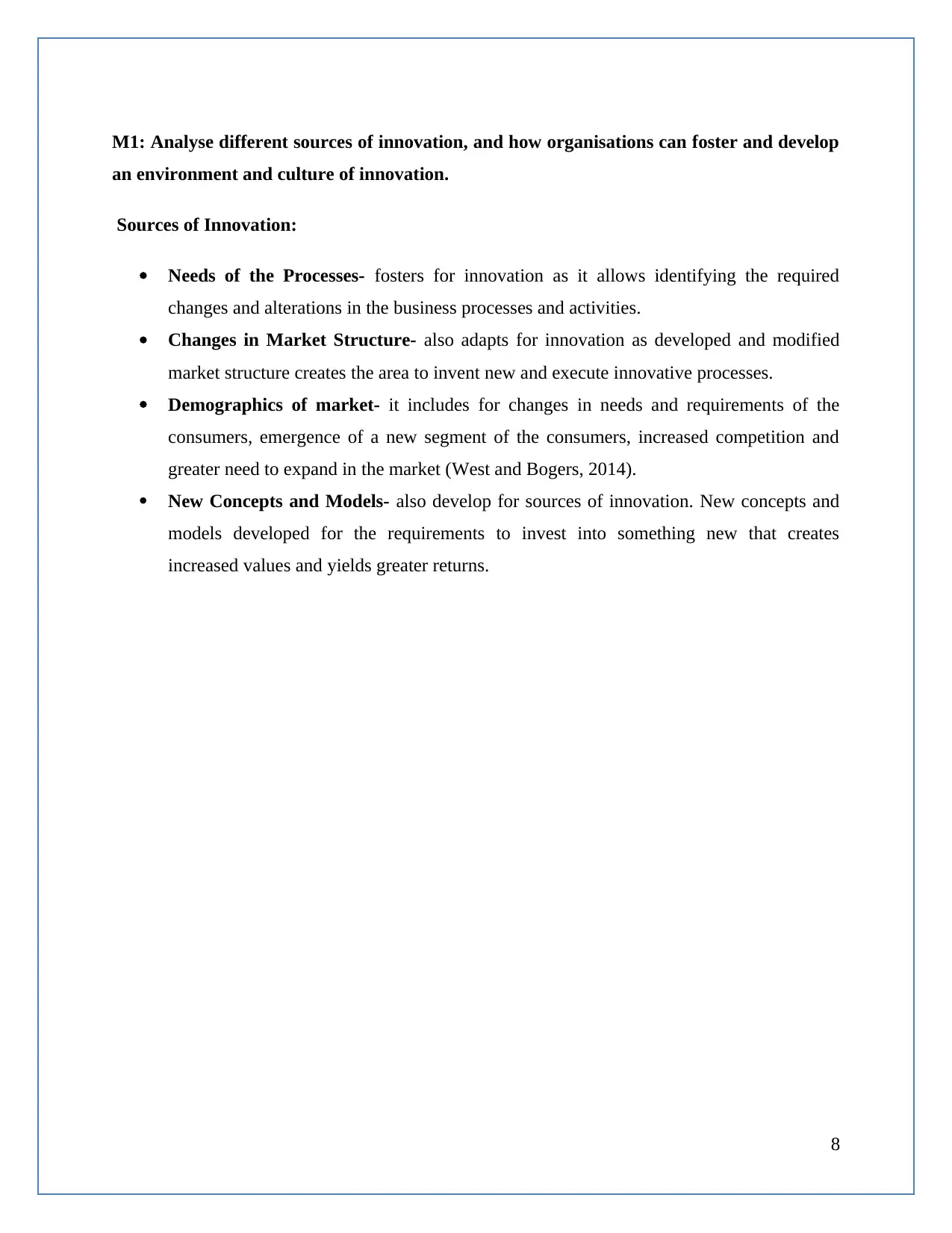
M1: Analyse different sources of innovation, and how organisations can foster and develop
an environment and culture of innovation.
Sources of Innovation:
Needs of the Processes- fosters for innovation as it allows identifying the required
changes and alterations in the business processes and activities.
Changes in Market Structure- also adapts for innovation as developed and modified
market structure creates the area to invent new and execute innovative processes.
Demographics of market- it includes for changes in needs and requirements of the
consumers, emergence of a new segment of the consumers, increased competition and
greater need to expand in the market (West and Bogers, 2014).
New Concepts and Models- also develop for sources of innovation. New concepts and
models developed for the requirements to invest into something new that creates
increased values and yields greater returns.
8
an environment and culture of innovation.
Sources of Innovation:
Needs of the Processes- fosters for innovation as it allows identifying the required
changes and alterations in the business processes and activities.
Changes in Market Structure- also adapts for innovation as developed and modified
market structure creates the area to invent new and execute innovative processes.
Demographics of market- it includes for changes in needs and requirements of the
consumers, emergence of a new segment of the consumers, increased competition and
greater need to expand in the market (West and Bogers, 2014).
New Concepts and Models- also develop for sources of innovation. New concepts and
models developed for the requirements to invest into something new that creates
increased values and yields greater returns.
8
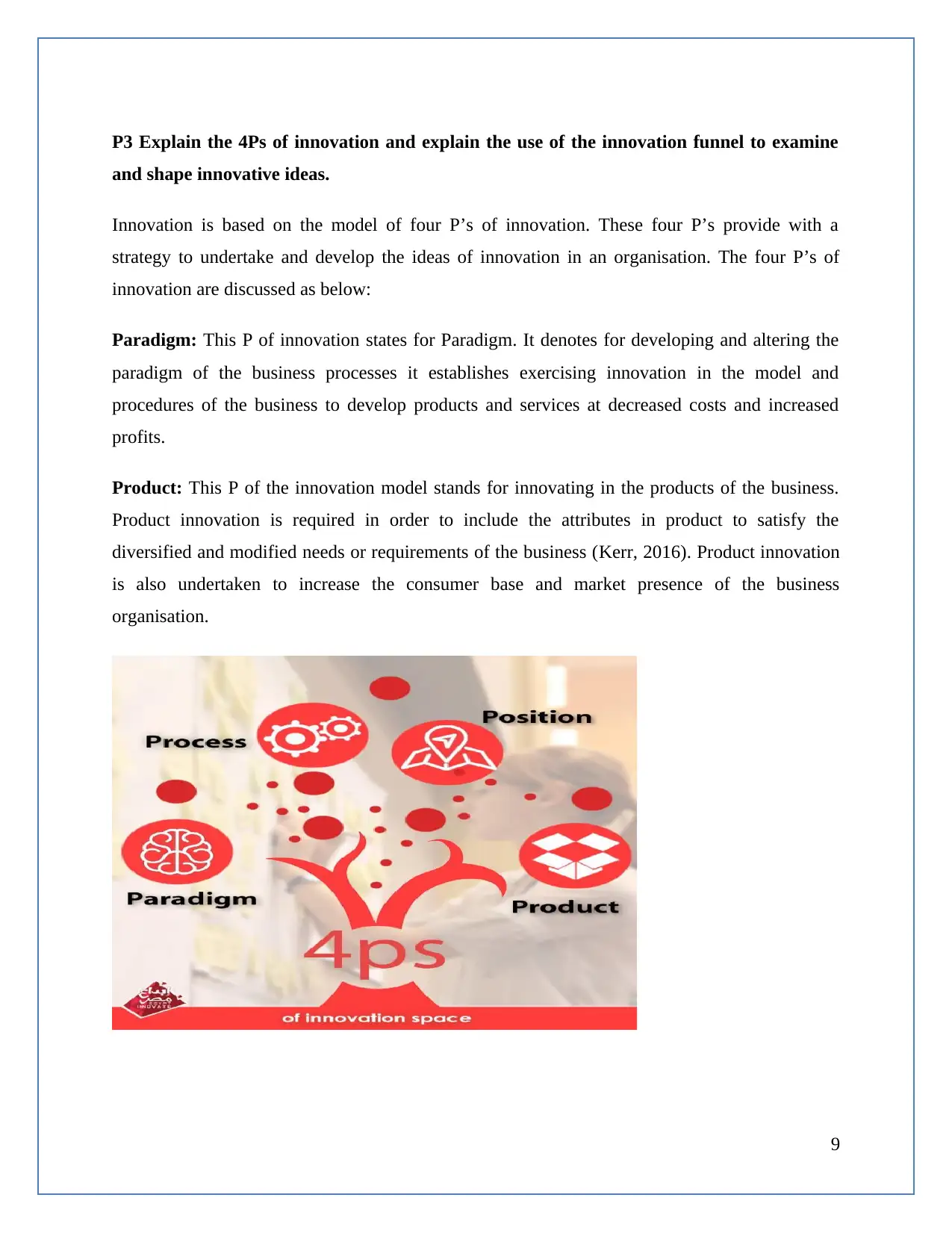
P3 Explain the 4Ps of innovation and explain the use of the innovation funnel to examine
and shape innovative ideas.
Innovation is based on the model of four P’s of innovation. These four P’s provide with a
strategy to undertake and develop the ideas of innovation in an organisation. The four P’s of
innovation are discussed as below:
Paradigm: This P of innovation states for Paradigm. It denotes for developing and altering the
paradigm of the business processes it establishes exercising innovation in the model and
procedures of the business to develop products and services at decreased costs and increased
profits.
Product: This P of the innovation model stands for innovating in the products of the business.
Product innovation is required in order to include the attributes in product to satisfy the
diversified and modified needs or requirements of the business (Kerr, 2016). Product innovation
is also undertaken to increase the consumer base and market presence of the business
organisation.
9
and shape innovative ideas.
Innovation is based on the model of four P’s of innovation. These four P’s provide with a
strategy to undertake and develop the ideas of innovation in an organisation. The four P’s of
innovation are discussed as below:
Paradigm: This P of innovation states for Paradigm. It denotes for developing and altering the
paradigm of the business processes it establishes exercising innovation in the model and
procedures of the business to develop products and services at decreased costs and increased
profits.
Product: This P of the innovation model stands for innovating in the products of the business.
Product innovation is required in order to include the attributes in product to satisfy the
diversified and modified needs or requirements of the business (Kerr, 2016). Product innovation
is also undertaken to increase the consumer base and market presence of the business
organisation.
9
⊘ This is a preview!⊘
Do you want full access?
Subscribe today to unlock all pages.

Trusted by 1+ million students worldwide
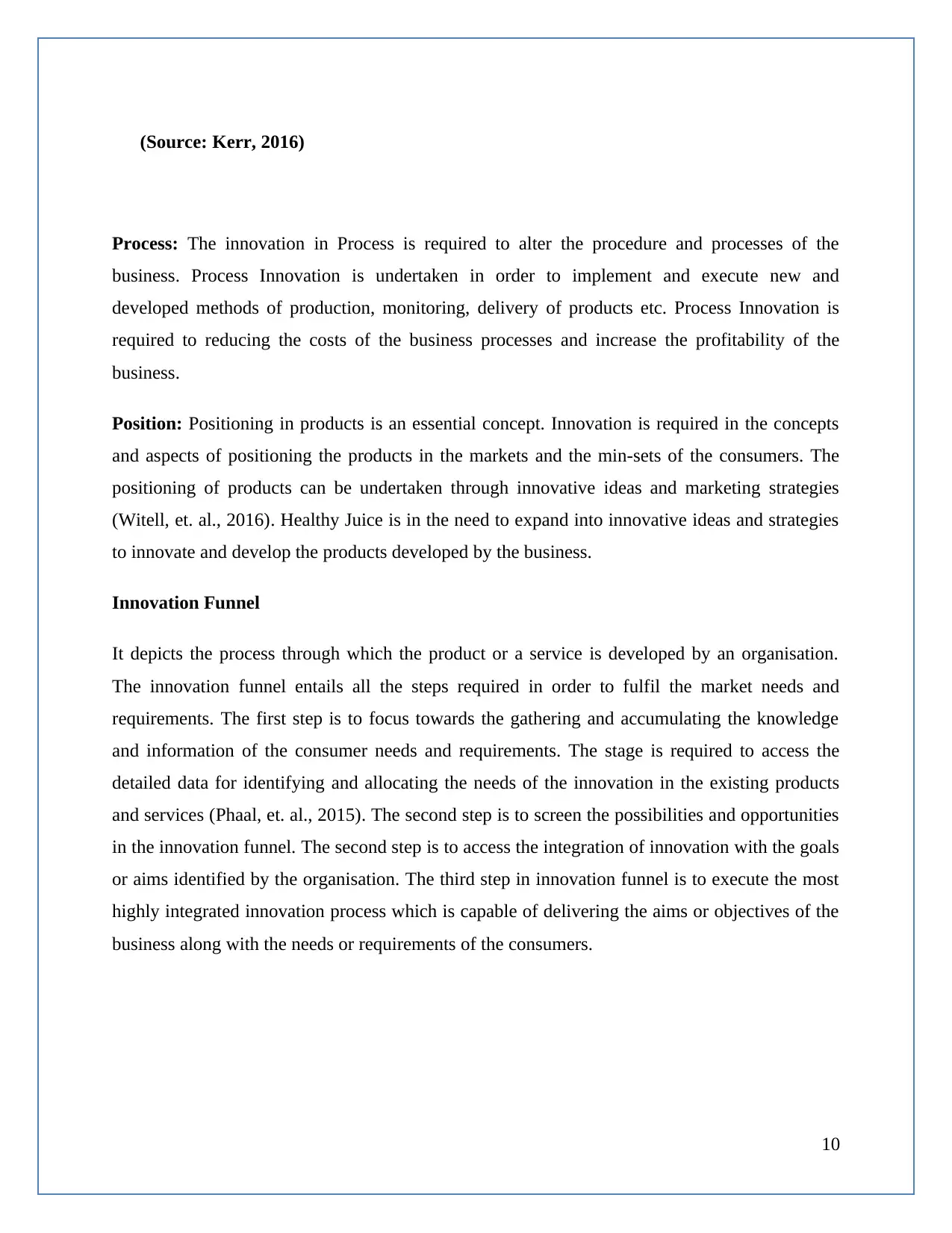
(Source: Kerr, 2016)
Process: The innovation in Process is required to alter the procedure and processes of the
business. Process Innovation is undertaken in order to implement and execute new and
developed methods of production, monitoring, delivery of products etc. Process Innovation is
required to reducing the costs of the business processes and increase the profitability of the
business.
Position: Positioning in products is an essential concept. Innovation is required in the concepts
and aspects of positioning the products in the markets and the min-sets of the consumers. The
positioning of products can be undertaken through innovative ideas and marketing strategies
(Witell, et. al., 2016). Healthy Juice is in the need to expand into innovative ideas and strategies
to innovate and develop the products developed by the business.
Innovation Funnel
It depicts the process through which the product or a service is developed by an organisation.
The innovation funnel entails all the steps required in order to fulfil the market needs and
requirements. The first step is to focus towards the gathering and accumulating the knowledge
and information of the consumer needs and requirements. The stage is required to access the
detailed data for identifying and allocating the needs of the innovation in the existing products
and services (Phaal, et. al., 2015). The second step is to screen the possibilities and opportunities
in the innovation funnel. The second step is to access the integration of innovation with the goals
or aims identified by the organisation. The third step in innovation funnel is to execute the most
highly integrated innovation process which is capable of delivering the aims or objectives of the
business along with the needs or requirements of the consumers.
10
Process: The innovation in Process is required to alter the procedure and processes of the
business. Process Innovation is undertaken in order to implement and execute new and
developed methods of production, monitoring, delivery of products etc. Process Innovation is
required to reducing the costs of the business processes and increase the profitability of the
business.
Position: Positioning in products is an essential concept. Innovation is required in the concepts
and aspects of positioning the products in the markets and the min-sets of the consumers. The
positioning of products can be undertaken through innovative ideas and marketing strategies
(Witell, et. al., 2016). Healthy Juice is in the need to expand into innovative ideas and strategies
to innovate and develop the products developed by the business.
Innovation Funnel
It depicts the process through which the product or a service is developed by an organisation.
The innovation funnel entails all the steps required in order to fulfil the market needs and
requirements. The first step is to focus towards the gathering and accumulating the knowledge
and information of the consumer needs and requirements. The stage is required to access the
detailed data for identifying and allocating the needs of the innovation in the existing products
and services (Phaal, et. al., 2015). The second step is to screen the possibilities and opportunities
in the innovation funnel. The second step is to access the integration of innovation with the goals
or aims identified by the organisation. The third step in innovation funnel is to execute the most
highly integrated innovation process which is capable of delivering the aims or objectives of the
business along with the needs or requirements of the consumers.
10
Paraphrase This Document
Need a fresh take? Get an instant paraphrase of this document with our AI Paraphraser
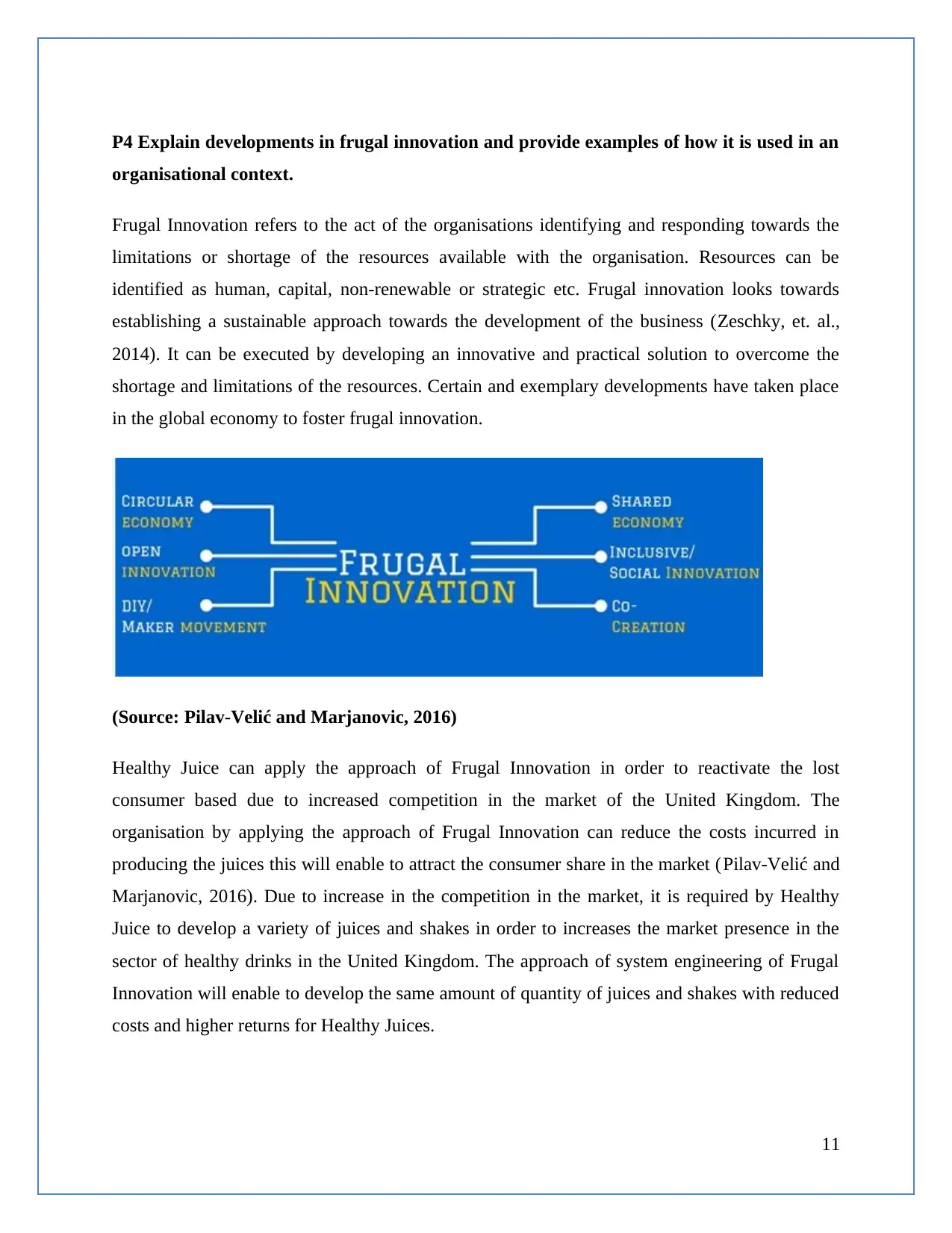
P4 Explain developments in frugal innovation and provide examples of how it is used in an
organisational context.
Frugal Innovation refers to the act of the organisations identifying and responding towards the
limitations or shortage of the resources available with the organisation. Resources can be
identified as human, capital, non-renewable or strategic etc. Frugal innovation looks towards
establishing a sustainable approach towards the development of the business (Zeschky, et. al.,
2014). It can be executed by developing an innovative and practical solution to overcome the
shortage and limitations of the resources. Certain and exemplary developments have taken place
in the global economy to foster frugal innovation.
(Source: Pilav-Velić and Marjanovic, 2016)
Healthy Juice can apply the approach of Frugal Innovation in order to reactivate the lost
consumer based due to increased competition in the market of the United Kingdom. The
organisation by applying the approach of Frugal Innovation can reduce the costs incurred in
producing the juices this will enable to attract the consumer share in the market (Pilav-Velić and
Marjanovic, 2016). Due to increase in the competition in the market, it is required by Healthy
Juice to develop a variety of juices and shakes in order to increases the market presence in the
sector of healthy drinks in the United Kingdom. The approach of system engineering of Frugal
Innovation will enable to develop the same amount of quantity of juices and shakes with reduced
costs and higher returns for Healthy Juices.
11
organisational context.
Frugal Innovation refers to the act of the organisations identifying and responding towards the
limitations or shortage of the resources available with the organisation. Resources can be
identified as human, capital, non-renewable or strategic etc. Frugal innovation looks towards
establishing a sustainable approach towards the development of the business (Zeschky, et. al.,
2014). It can be executed by developing an innovative and practical solution to overcome the
shortage and limitations of the resources. Certain and exemplary developments have taken place
in the global economy to foster frugal innovation.
(Source: Pilav-Velić and Marjanovic, 2016)
Healthy Juice can apply the approach of Frugal Innovation in order to reactivate the lost
consumer based due to increased competition in the market of the United Kingdom. The
organisation by applying the approach of Frugal Innovation can reduce the costs incurred in
producing the juices this will enable to attract the consumer share in the market (Pilav-Velić and
Marjanovic, 2016). Due to increase in the competition in the market, it is required by Healthy
Juice to develop a variety of juices and shakes in order to increases the market presence in the
sector of healthy drinks in the United Kingdom. The approach of system engineering of Frugal
Innovation will enable to develop the same amount of quantity of juices and shakes with reduced
costs and higher returns for Healthy Juices.
11
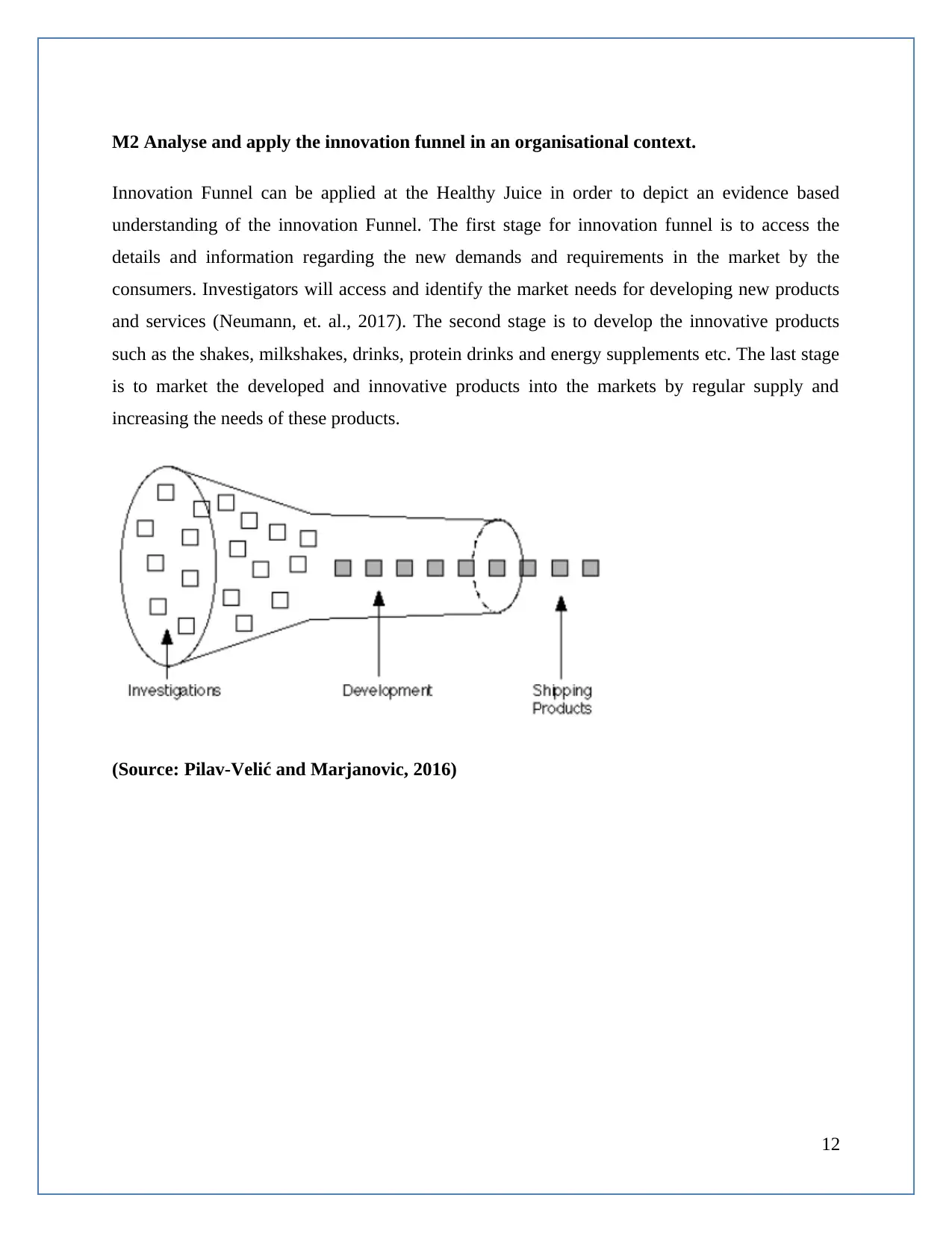
M2 Analyse and apply the innovation funnel in an organisational context.
Innovation Funnel can be applied at the Healthy Juice in order to depict an evidence based
understanding of the innovation Funnel. The first stage for innovation funnel is to access the
details and information regarding the new demands and requirements in the market by the
consumers. Investigators will access and identify the market needs for developing new products
and services (Neumann, et. al., 2017). The second stage is to develop the innovative products
such as the shakes, milkshakes, drinks, protein drinks and energy supplements etc. The last stage
is to market the developed and innovative products into the markets by regular supply and
increasing the needs of these products.
(Source: Pilav-Velić and Marjanovic, 2016)
12
Innovation Funnel can be applied at the Healthy Juice in order to depict an evidence based
understanding of the innovation Funnel. The first stage for innovation funnel is to access the
details and information regarding the new demands and requirements in the market by the
consumers. Investigators will access and identify the market needs for developing new products
and services (Neumann, et. al., 2017). The second stage is to develop the innovative products
such as the shakes, milkshakes, drinks, protein drinks and energy supplements etc. The last stage
is to market the developed and innovative products into the markets by regular supply and
increasing the needs of these products.
(Source: Pilav-Velić and Marjanovic, 2016)
12
⊘ This is a preview!⊘
Do you want full access?
Subscribe today to unlock all pages.

Trusted by 1+ million students worldwide
1 out of 23
Related Documents
Your All-in-One AI-Powered Toolkit for Academic Success.
+13062052269
info@desklib.com
Available 24*7 on WhatsApp / Email
![[object Object]](/_next/static/media/star-bottom.7253800d.svg)
Unlock your academic potential
Copyright © 2020–2025 A2Z Services. All Rights Reserved. Developed and managed by ZUCOL.





